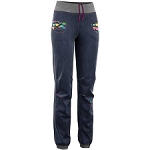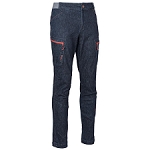It’s one of our most abused articles of clothing. Climbing pants don’t just have to stand up to a beating against sharp, abrasive rock, they have to do so while still being elastic enough not to hinder our movement while climbing. In this article we’ll talk about different types of climbing pants and what to look for to get the right pair for you.

Durability with freedom of movement—the holy grail of climbing pants. Photo by Jenya Kazbekova/ SCARPA
Over the years climbing pants have gone through many changes and adaptations before the climbing-specific designs we see today. From the classic knickerbockers used by multiple generations of climbers to the use of pants from other sports as diverse as aerobics tights, track, painting and yoga pants, or as is commonly seen today, hiking pants or just normal gym sweats. The concept of a sport-specific technical pant for climbing has been a recent development, seen only in the past few years.
Before looking at the technical characteristics of climbing pants, we need to ask ourselves – what do actually need a pair of climbing pants to do? The problem we run into is that the clothing for rock climbing has to do multiple (and sometimes contradictory) things at the same time, and manufactures come up with different and varied answers on how to balance these contradictory needs.
First, we should be aware that different types of climbing have different needs. Highly dynamic types of climbing such as bouldering or speed climbing require materials and designs that prioritize freedom of movement and breathability, whereas clothes for other “slower” styles such as trad climbing, big-wall, or aid climbing require a focus more on durability and even warmth.
Let’s take a look at some general characteristics that you should look for in a pair of rock climbing pants.
Freedom of Movement
Given the dynamic, athletic nature of climbing, in which mobility is key, clothing that doesn’t restrict your movement is fundamental. Especially for sport climbing and bouldering, freedom of movement is a key factor. On the other hand, pants designed for mountaineering or ice climbing are a more restrictive as durability and protection are key for these types of climbing.

Freedom of movement and durability. Bouldering session with the Rab Obtuse pant. Photo by Rab.
Brands use two strategies to design pants that are comfortable and allow a full range of motion. First, they incorporate a high percentage of elastic materials such as elastane or lycra into the composition. Second they use sewing patterns with elements that favor mobility , such as articulated knees and gusseted crotches (discussed below).
The weight of the pants and their compatibility with a harness are two other points you’ll need to consider when deciding on the pant you’ll need for a particular type of climbing.
Durability
Except maybe in caving, there aren’t many outdoor activities in which the durability of your clothes is going to be put to the test as much as in climbing. It’s true that on some climbs you can see climbers practically float up the rock face in relaxed, seemingly effortless movements, barely touching the wall. However, we also have chimneys, off widths, and moves such as knee bars, where your contact with the wall is going to be more intense and is going to put your clothes to the test.

Durable materials are necessary to stand up to the rock. Photo by Jan Novak / SCARPA
Abrasion against rock is the major source of wear and tear on climbing clothes, but not the only one. The continued friction again a harness and the explosive moves inherent to some types of climbing can also contribute to premature wear that we’d like to prevent through the use of quality materials. Normally climbing pants have a high thread count, though this is a piece of information that’s hard to find among the technical details provided by the brands. To learn more about thread count and other technical terms used for outdoor gear, you can have a look at another article on our blog,“Cuin, Denier, RET, Drop, Hydrostatic Head...Technical Terms for Outdoor Gear”.
Breathability
Possibly the most overlooked factor when choosing climbing pants, although it can be an important one. For long approaches and returns and when climbing in warm temperatures, a breathable pant make a big impact on comfort for sure.
A pant’s breathability is generally inversely proportional to its weight, though not always. A heavier, tougher fabric will usually not be as efficient evacuating moisture as a lightweight one. You will have to decide what balance between breathability and durability is right for you , based on what king of climbing you do and in what conditions.
Warmth
An important factor when weather conditions can turn bad or alpine environments are involved, or when the safety of a warm shelter is far away. The average sport climber or boulderer won’t spend too much time struggling against poor conditions with cold fingers, but as with any other outdoor activity the weather is a variable beyond our control, and being prepared is also recommended.
Recommended Characteristics for Climbing Pants
Here we’ll discuss some other recommended characteristics you should consider when buying a pair of climbing pants.
Durable, Elastic Fabrics
As with all outdoor textile and especially pants, nylon is the most common material used . It’s durable, lightweight and soft to the touch. Climbing is the last outdoor sport in which cotton still holds out against the overwhelming dominance of synthetic fibers for technical clothing. Generally used only for bouldering, indoor training and sport climbing, cotton is durable and has unbeatable next-to-skin comfort, which outweighs its sever lack of breathability.
Other cotton-based materials such as denim and even corduroy have a relatively wide representation among boulderers and sport climbers, especially when compared to other activities such as hiking or mountaineering, where synthetic fibers have mostly taken over.
In general, though, climbing pants for multi-pitch or big-wall climbing or mountaineering will be made of nylon, where a lightweight, durable fabric is a priority. On the other hand, pants for sport climbing and bouldering are usually made of cotton with a mix of elastane (aka Lycra or Spandex – at times even up to 12%) , favoring freedom of movement and comfort. Some brands have also experimented with hemp and polyester.

Rab Obtuse pant, made from nylon and elastane
Flat, Elastic Waistband
One of the most important points, even if you’re not going to use the pants with a harness. A flat, wide, elastic waistband will distribute the pressure against your waist and prevent wrinkles and pressure points from forming. Flat, minimalist seams in areas where your harness goes also help reduce pressure points and chafing.

Aria Light Pant from Crazy. Flat, wide elastic waistband, for maximum comfort while wearing a harness
Articulated Knees
One of biggest advancements in outdoor clothing is with movement-friendly clothing pattern designs. For example pants designed with articulated knees allow the broad range of motion required for rock climbing.
Gusseted Crotch
Another design feature that enhances not only freedom of movement in pants but also durability is the gusseted crotch. A gusset is a triangle- or diamond- shaped patch of fabric that is sewn in where the leg inseams and the front and back seams all meet together at the crotch, allowing unimpeded movement of your legs. The gusset also reduces strain on this area of the pants, making them last longer.

E9 Rondo Pant, with articulated knees and a gusseted crotch for improved freedom of movement
UV Protection
Clothing brands don’t typically specify the Ultraviolet Protection Factor (UPF) of climbing pants like they do with shirts and hats. It’s a shame, because it’s a value that is always useful to know. For multi-pitch climbing on routes in the sun your skin can be damaged by long hours on the wall without the proper protection from your clothes. For more on the subject, have a look at our article on “UPF Clothing: Ultraviolet Protection in the Outdoors”.
Pockets and Other Accessories
Not all pants pockets are useful while climbing. Classic front pockets are hard to access while wearing a harness, and rigid items like a phone can get in the way as the pockets are located where your legs need to bend and move while climbing.

Ternua Top Out Pant. Thigh pockets allow for easier access with a harness on
The best solution for multi-pitch climbing is to have thigh pockets , which are out of the way of the harness, easily accessible and generally won’t bother you while you’re climbing. Zippered pockets will add extra security against objects from falling out, of course.
Bouldering pants generally have an elastic brush loop or two, convenient for brushing holds. Elastic cuffs are also handy for seeing feet more easily while you climb, not stepping on your pants with your rock shoes, and for rolling your pants up to your knees when it’s hot out.
What about length?
A pair of climbing shorts is obviously much cooler than long pants, making them an ideal choice for summer climbing. Even if protection below the knee is an issue, the recently growing popularity of knee pads can take care of that.
Long climbing pants often come with adjustable ankle cinches, which allow you to roll up the legs to just over your ankles or oven just below your knees for when it’s warm out. The versatility of long climbing pants is undisputed. However, there is a third option: the ¾ pant. Cool for summer temperatures but with needed protection in the knees, ¾ pants are a good compromise between temperature regulation, protection and weight.

3/4 climbing pants
Finding Pants to Fit Your Style
Just like there is no one type of climbing, there is not just one type of climbing pant. You’ll need to find the right mix for you and your type (or types) of climbing, taking into account the different factors discussed above. Be sure to browse our catalog of climbing pants and contact our customer service department for questions on a particular model, or any other outdoor needs.
Webshop: www.barrabes.com/en-gb/















Leave a comment
Be the first to comment on this article.